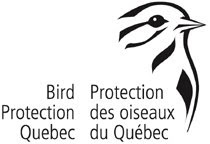Quai de Rivière-Ouelle: More than 2000 birds of 32 species. Two hours thirty minutes of observation (6:30 to 9:00) in one stationary end of the wharf without getting bored. It gives: Common Loon ... 20 (In flight, generally solitary or in pairs, in both directions) Red-throated Loon ... 45 (some fishing but a majority of adults and youth, flying east) Red-necked Grebe ... 4 (A group of two and two solitary flying east) Wilson's Storm-petrel 1 ... My first lifer at the dock. A Northern gannet (adult flying off to the west) ... Double-crested Cormorant 200 (several small groups flying west) Great Blue Heron ... 5 (in the bay and beach ) Snow Goose ... 300 (a few groups on the fly to the west. A probable Ross' Goose in a group.
Not having seen the details of the bill and because of hybrids ...) Canada Goose ... 600 (several hundred in the water early in the morning) Black Duck ... 55 (number of groups, often with mallards, mostly headed west) Mallard ... 30 (several with Black ducks) American Wigeon ... 2 (male and female separately , flying with Mallards and Black duck) Ring-necked Duck ... 3 (three females flying in a mixed group of scaup) Greater Scaup ... 40 (several small groups, sometimes with Scoters in flight to the east) Lesser Scaup ... 12 (Two water near the wharf, a few other flying among the Greater scaup) Common Eider ... 70 (groups flying east) King Eider ...1 the first bird that I see, coming down the dock this morning! A female is floating and swimming to the east not far ahead. I clearly observed the pattern of the head and especially the shape of the beak. Black Scoter ... 4 (Only one group, four males in flight to the east) Surf Scoter ... 70 (several small groups the majority flying east) White-winged Scoter ... 28 (small groups the majority flying east) Common Goldeneye ... 4 (all solitary, flying east) Red-breasted Merganser... 15 (Some pairs or small groups to the east) Semipalmated Plover ... 30 (some on the beach and groups in flight) Sanderling ... 8 (some with Semipalmated Sandpiper and Dunlin) Semipalmated Sandpiper ... 100 (number of groups in flight headed east) Dunlin ... 50 (number of groups, often with Semipalmated Sandpiper, flying east) Ring-Billed Gull ... 300 (many, almost all flying east) Herring Gull. .. 5 Great black-backed Gull... 3 Razorbill 152 ... many small groups (usually between 3 and 10 ind. but up to 24 in one group!) flying mainly to the east. My highest lifetime tota at the dock! Black guillemot ... 5 (groups of 2 and 3 in flight headed east)
Plus de 2000 oiseaux appartenant à 32 espèces.Deux heures trente minute d'observation (6h30-9h00) seul en stationnaire au bout du quai sans s'ennuyer. Ça donne: Plongeon huard ...20 (Au vol, généralement en solitaire ou par deux, dans les deux directions) Plongeon catmarin ...45 (Quelques'uns à la pêche mais une majorité, adultes et jeunes, au vol vers l'est) Grèbe jougris ...4 (Un groupe de 2 et deux solitaires au vol vers l'est) Océanite de Wilson ...1 Mon premier à vie au quai! Fou de Bassan ...1 (adulte au large en vol vers l'ouest) Cormoran à aigrettes ...200 (Plusieurs petits groupes au vol vers l'ouest) Grand Héron ...5 (dans la baie et sur la plage) Oie des neiges ...300 (Quelques groupes au vol vers l'ouest. Aussi une probable Oie de Ross parmi un groupe. N'ayant pas vu les détails du bec et à cause des hybrides...) Bernache du Canada ...600 (Plusieurs centaines à l'eau tôt le matin) Canard noir ...55 (Plusieurs groupes, souvent avec des colverts, le plus souvent vers l'ouest) Canard colvert ...30 (Plusieurs avec les C. noirs) Canard d'Amérique ...2 (un mâle et une femelle séparément, au vol avec des C. noirs et colverts) Fuligule à collier ...3 (trois femelles au vol dans un groupe mixte de fuligules) Fuligule milouinan ...40 (plusieurs petits groupes, parfois avec des macreuses, au vol vers l'est) Petit Fuligule ...12 (Deux à l'eau près du quai, quelques autres au vol parmi les F. milouinan) Eider à duvet ...70 (plusieurs groupes au vol vers l'est) Eider à tête grise ...1 Le premier oiseau que je vois en arrivant au bout du quai ce matin! Une femelle est posé et nage vers l'est non-loin devant. J'ai très bien observé le motif de la tête et surtout la forme du bec.Macreuse à bec jaune ...4 (Un seul groupe, 4 mâles en vol vers l'est) Macreuse à front blanc ...70 (plusieurs petits groupes au vol vers l'est pour la majorité) Macreuse brune ...28 (plusieurs petits groupes au vol vers l'est pour la majorité) Garrot à oeil d'or ...4 (tous des solitaires, au vol vers l'est) Harle huppé ...15 (Quelques duos ou petits groupes vers l'est) Pluvier semipalmé ...30 (quelques'uns sur la plage et groupes au vol) Bécasseau sanderling ...8 (Quelques'uns avec les B. semipalmés et variables) Bécasseau semipalmé ...100 (Plusieurs groupes au vol vers l'est) Bécasseau variable ...50 (plusieurs groupes, souvent avec des B. semipalmés, au vol vers l'est) Goéland à bec cerclé ...300 (Nombreux, presque tous au vol vers l'est) Goéland argenté ...5 Goéland marin ...3 Petit Pingouin ...152 Nombreux petits groupes (généralement entre 3 et 10 ind. mais jusqu'à 24 dans un seul groupe!) au vol principalement vers l'est. Mon plus haut total à vie au quai! Guillemot à mirroir ...5 (un groupe de 2 et 3 au vol vers l'est) - Jean-François Rousseau
Wednesday, September 28, 2011
Subscribe to:
Post Comments (Atom)





No comments:
Post a Comment